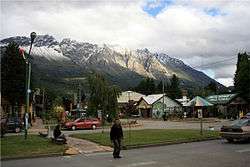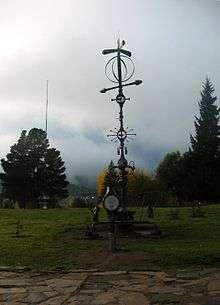El Bolsón, Río Negro
| El Bolsón | |
|---|---|
| Town | |
 | |
 El Bolsón Location of El Bolsón in Argentina | |
| Coordinates: 41°58′S 71°32′W / 41.967°S 71.533°WCoordinates: 41°58′S 71°32′W / 41.967°S 71.533°W | |
| Country | Argentina |
| Province | Rio Negro |
| Department | Bariloche |
| Elevation | 422 m (1,385 ft) |
| Population | |
| • Total | 19,009 |
| Demonym(s) | bolsonense |
| Time zone | ART (UTC-3) |
| CPA base | U8430 |
| Dialing code | +54 2944 |
| Climate | Csb |

El Bolsón is a town situated in the southwest of Río Negro Province, Argentina, at the foot of the Piltriquitron Mountain. Due to a series of valleys through the mountains of Chile to the Pacific Ocean, El Bolsón has an unusually mild climate for its southern location.
El Bolsón area's first non-indigenous inhabitants were German immigrants that arrived to the valley from Chile as an offshoot of the colonisation of Llanquihue. In the 1970s hippies from Buenos Aires migrated to El Bolsón; some of them practised horticulture and made handcrafts.
El Bolsón has a tourism economy based on an outdoor artisan market, fly fishing, trekking, rafting, climbing, and other outdoor activities in the surrounding lakes and mountains. The nature tourism offers are complemented with the production of cheeses, smoked trout, special brew beer, regional chocolates and ice cream, as well as organic and wild-crafted jams and preserves, particularly elderberries.
Communication
El Bolsón is located approximately 120 km south of the major city of San Carlos de Bariloche and is served by El Bolsón Airport.
Climate
El Bolsón has a cool Mediterranean climate (Köppen climate classification Csb) owing to its rain shadow location. Winters are cold with a July mean of 3.5 °C (38.3 °F) with nighttime temperatures regularly falling below 0 °C (32.0 °F).[1] During cold waves, temperatures can occasionally fall below −10 °C (14.0 °F).[2] During the winter months, precipitation is abundant frequent (mostly rainfall and occasionally snowfalls), resulting in most days being overcast, averaging 16-17 overcast days from June to August.[3] Spring and fall are transition seasons featuring mild daytime temperatures and cold nighttime temperatures.[1] Summers are mild and sunnier with warm temperatures during the day, averaging 24.1 °C (75.4 °F) in January and cool nights, averaging 7.4 °C (45.3 °F).[1][2][3] Frosts can even occur during the summer months.[1][2][3] Owing to its location in a valley, wind speeds are lower ranging from a low of 4 kilometres per hour (2.5 mph) in May and June to a high of 9 kilometres per hour (5.6 mph) in January.[1]
| Climate data for El Bolsón, Río Negro (1941–1978) | |||||||||||||
|---|---|---|---|---|---|---|---|---|---|---|---|---|---|
| Month | Jan | Feb | Mar | Apr | May | Jun | Jul | Aug | Sep | Oct | Nov | Dec | Year |
| Record high °C (°F) | 35.6 (96.1) |
37.3 (99.1) |
33.5 (92.3) |
26.0 (78.8) |
24.2 (75.6) |
20.8 (69.4) |
18.5 (65.3) |
20.2 (68.4) |
23.9 (75) |
32.1 (89.8) |
31.4 (88.5) |
35.1 (95.2) |
37.3 (99.1) |
| Average high °C (°F) | 24.1 (75.4) |
24.0 (75.2) |
21.7 (71.1) |
16.9 (62.4) |
12.3 (54.1) |
8.7 (47.7) |
8.4 (47.1) |
10.4 (50.7) |
13.4 (56.1) |
17.3 (63.1) |
20.6 (69.1) |
22.7 (72.9) |
16.7 (62.1) |
| Daily mean °C (°F) | 16.0 (60.8) |
15.2 (59.4) |
12.6 (54.7) |
9.1 (48.4) |
6.6 (43.9) |
3.8 (38.8) |
3.5 (38.3) |
4.7 (40.5) |
6.9 (44.4) |
10.0 (50) |
13.1 (55.6) |
15.1 (59.2) |
9.7 (49.5) |
| Average low °C (°F) | 7.4 (45.3) |
6.7 (44.1) |
5.1 (41.2) |
2.7 (36.9) |
1.8 (35.2) |
0.2 (32.4) |
−0.5 (31.1) |
−0.2 (31.6) |
1.5 (34.7) |
2.7 (36.9) |
4.8 (40.6) |
6.3 (43.3) |
3.2 (37.8) |
| Record low °C (°F) | −1.8 (28.8) |
−1.8 (28.8) |
−4.3 (24.3) |
−7.1 (19.2) |
−10.5 (13.1) |
−11.7 (10.9) |
−10.3 (13.5) |
−8.4 (16.9) |
−8.3 (17.1) |
−5.3 (22.5) |
−3.5 (25.7) |
−2.4 (27.7) |
−11.7 (10.9) |
| Average precipitation mm (inches) | 30.1 (1.185) |
28.3 (1.114) |
39.3 (1.547) |
68.3 (2.689) |
138.0 (5.433) |
151.0 (5.945) |
171.5 (6.752) |
118.2 (4.654) |
63.1 (2.484) |
38.0 (1.496) |
31.8 (1.252) |
45.3 (1.783) |
922.9 (36.335) |
| Average rainfall mm (inches) | 30.1 (1.185) |
28.3 (1.114) |
38.2 (1.504) |
68.3 (2.689) |
136.4 (5.37) |
143.3 (5.642) |
161.3 (6.35) |
115.4 (4.543) |
62.4 (2.457) |
37.8 (1.488) |
31.8 (1.252) |
45.3 (1.783) |
898.6 (35.378) |
| Average snowfall cm (inches) | 0.0 (0) |
0.0 (0) |
1.1 (0.43) |
0.0 (0) |
1.6 (0.63) |
7.7 (3.03) |
10.2 (4.02) |
2.8 (1.1) |
0.7 (0.28) |
0.2 (0.08) |
0.0 (0) |
0.0 (0) |
24.3 (9.57) |
| Average rainy days | 6.0 | 4.5 | 6.5 | 10.5 | 13.5 | 14.5 | 15.5 | 14.5 | 11.0 | 8.5 | 6.5 | 7.5 | 119.0 |
| Average relative humidity (%) | 61.5 | 65.8 | 72.3 | 78.5 | 85.0 | 86.8 | 86.0 | 81.0 | 75.0 | 68.5 | 63.8 | 61.3 | 73.8 |
| Source #1: Instituto Nacional de Tecnología Agropecuaria[2] | |||||||||||||
| Source #2: Secretaria de Mineria (humidity 1941–1980)[3] | |||||||||||||
 Río Azul, near El Bolsón.
Río Azul, near El Bolsón. View of El Bolsón from the Piltriquitron mountain.
View of El Bolsón from the Piltriquitron mountain.
References
- 1 2 3 4 5 "Datos Estadísticos (Período 1971-1980)" (in Spanish). Servicio Meteorológico Nacional. Retrieved June 27, 2014.
- 1 2 3 4 Bustos, José; Rocchi, Victor. "Caracterizacíon Termopluviométrica de Algunas Estaciones Meteorológicas de Rio Negro Y Neuquén" (PDF) (in Spanish). Instituto Nacional de Tecnología Agropecuaria. p. 12. Retrieved June 27, 2014.
- 1 2 3 4 "Provincia de Rio Negro − Clima Y Meteorologia: Datos Meteorologicos Y Pluviometicos" (in Spanish). Secretaria de Mineria de la Nacion (Argentina). Archived from the original on July 4, 2015. Retrieved June 27, 2014.
External links
| Wikimedia Commons has media related to El Bolsón. |
- Official website
 El Bolsón travel guide from Wikivoyage
El Bolsón travel guide from Wikivoyage- El Bolsón on YouTube
